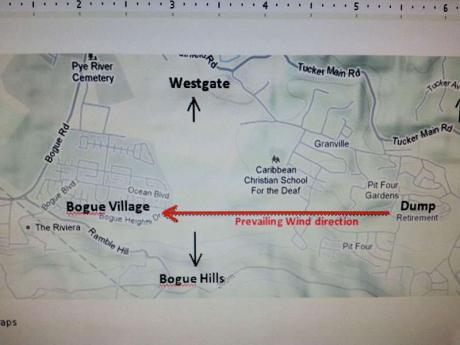Wake up and smell the smog!
THE EDITOR, Sir:
It seems the smog that blankets Bogue Village at nights and early mornings, particularly for at least the seven days starting from March 19, 2013, escapes the notice of all concerned. No one is concerned that while they sleep they are inhaling, very likely, pollutants and heavy metals with high bio-accumulation rates and carcinogenic effects.
The source of this concern: the smoke from the Retirement garbage dump, which serves as the municipal dumping site for a wide range of unsorted waste - from lead batteries, to fluorescent tubes, to old electronic items and chemicals.
What exacerbates the situation is the natural phenomenon of temperature reversal that occurs early mornings because of the topographical feature of the area. To elaborate, Bogue Village lies along a valley which sits between two elevated land features, the hills of Bogue to the south and the Westgate Hills in the north. (Pilots are very much aware of this topographical feature, which frequently forms part of their landing approach into Sangster Interna-tional Airport and is referred to as 'the right downwind').
The air at the top of these hills cools at night because of the natural process of daily temperature changes. At night, the cooler air is now denser (heavier) and thus descends from the top of these elevated hills and settles over the lower valley area, namely, Bogue Village. This natural process should be desirable, as it produces cooler more pleasant temperatures in the nights and early mornings.
The problem, however, occurs when this heavy, denser air becomes polluted with smoke from the Retirement dump. The smoke from the Retirement dump, located at the eastern end of the valley, now becomes trapped in this cool air that settles over the Bogue Village area, which is situated at the western end of the valley and of the dump.
This creates thick smog that lingers for the duration of the night. The reduction in land/sea breezes that generally blow from east to west along the valley and out to sea results in the polluted smog being trapped until after sunrise. This is so as at sunrise the heat from the sun heats up the polluted air, now causing it to become less dense (lighter). The lighter polluted air that rises upward from the valley is now able to be blown away to sea by the now very active daytime westerly winds.
The process described above may be the reason this issue escapes the notice of so many. For instance, when calls are made to the National Solid Waste Management Authority, the response is that there is no such smoke. There is also the possibility of olfactory exhaustion.
The smoke is present at nights after retiring to bed and then goes away by the time most wake. The situation is different for those who are plagued by respiratory distresses at night and are able to see the smog described above. They are far from oblivious to the presence of the smoke.
The smoke and the effects of the temperature reversal are sufficient to cause severe sinusitis, asthma attacks, and more frequent colds. Even for those unaffected in this way, the effects may be, unbeknown to them, more insidious, as the toxic and polluted air is being inhaled as house occupants sleep.
Who will do something about this issue? Some, ignorant to the above processes, will ask, 'What issue?' It is hoped the above will serve to enlighten such ones to the point of doing something about this increasing health hazard.
J.Q.X.
St James

